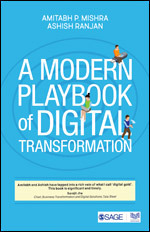by Amitabh P Mishra & Ashish Ranjan, co-authors, A Modern Playbook of Digital Transformation
Let’s assume you have figured out your Digital Transformation strategy, and have already embarked on the execution of the strategy that includes initiatives based on analytics and IoT. Now, however, due to a number of reasons, senior management wishes you to foray into AI – e.g. it is expected to provide a competitive advantage or enhance the image of the organization or its ability to attract top talent.Among the first questions that you’ll need to answer are: Does AI have a place in my industry? If it does, where should I start?
The concept of artificial intelligence is widely misunderstood. The reality is, most of what passes for AI today doesn’t contain any element of ‘intelligence.’ For example, if your HR system is voice-enabled and responds to your questions and requests, it’d be referred to as ‘AI technology.’ In reality, the system must include the element of learning in order to be called AI.
AI is a journey, of which RPA (robotic process automation) is the first step. RPA mimics human actions, while AI simulates human intelligence. In other words, RPA merely ‘does,’ while AI ‘thinks, does, and grows more intelligent with time.’
Therefore, consider starting your AI journey with RPA as the first step, e.g. to automate your HR processes such as reimbursement or payroll processing, or finance processes such as GST, taxes, Account Payables or Receivables. This technology primarily uses ‘chatbots,’ or simply ‘bots,’ that automatically performs manual, repetitive tasks.
Here’s an example of a business scenario RPA can help you automate: business travel. The key challenge is the volume of invoices from the travel partners or agencies, the time and effort to process the paperwork (the invoices along with supporting documents). The repetitive nature of the task makes it eminently suited for automation. The workforce employed in handling this task can be released for higher value-add tasks.
Now, let’s take a look at the scope of the task. For a company with $1B of annual sales, it may translate into the following order of volume of paperwork per month: 4,000 airline invoices, 6,000 hotel invoices, and 2,500 taxicab invoices.
Your objectives could be:
- 75% reduction in manual data extraction. RPA technology will improve the effectiveness of automated scanning and data extraction.
- 100% integration with ERP and other systems that will use the extracted data in downstream systems.
- Reduction of manpower requirement by 80%, in terms of FTEs.
You may then evaluate the competing proposals on the basis of a framework consisting of: (a) architectural fitment, (b) financial benefit, (c) ease of adoption and use, (d) time taken to realize the benefit, and (e) total cost of deployment and ownership.
Once you pick the product and the partner, the next question is whether you’d want to go for a full-fledged implementation perform a PoC first. In order to minimize your risk and to be able to demonstrate success quickly to senior management, a PoC may make sense.
A word here about senior management buy-in. You may want to follow a two-pronged approach: first, provide annualized benefit numbers, clearly mentioning the source (e.g. $0.8M reduction of costs due to 75% lower FTE requirement). Second, portray the benefits as direct, i.e. revenue increase or cost reduction. Anything else would be indirect – e.g. increase in employee productivity. Senior managers would always ask you: so what if we increase productivity? Can we reduce our headcount? If not, this is only an indirect benefit.
RPA is not an end in itself, but a required step in the journey to incorporate AI into your Digital Transformation journey. By following a deliberate process to identify a suitable business problem, and a thoughtful process to pick a product, a partner and a strategy, you can get AI to go work for you

On the off chance that you need to investigate it further, take a stab at perusing the Wikipedia (free on-line reference book) passage and possibly downloading something like Prolog to have a take a quick trip and see what genuine AI resembles. artificial intelligence training in pune
ReplyDeleteThank you so much for sharing all this wonderful information !!!! It is so appreciated!! You have good humor in your blogs. So much helpful and easy to read!
ReplyDeleteMachine learning training in Pune
Hello! Want to get the best results in entity annotation for your business? Our company provides first-class Entity Annotation services with the help of the best remote specialists. They have a wide range of knowledge and experience in various industries. Trust us and get results that will exceed your expectations! >> useful content
ReplyDelete